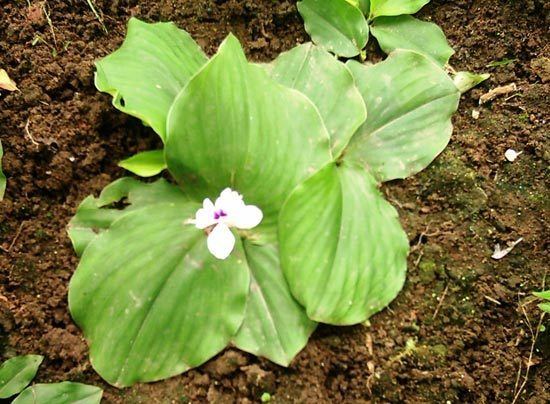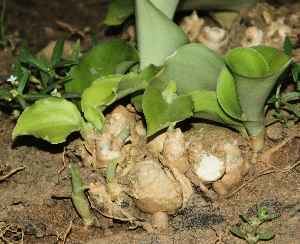Tribe Kaempferia Scientific name Kaempferia galanga Rank Species | Subfamily Zingiberoideae Genus Kaempferia Higher classification Kaempferia | |
 | ||
Similar Greater Galangal, Temulawak, Candlenut, Indonesian bay leaf, Bird's eye chili | ||
Kaempferia galanga, commonly known as kencur, aromatic ginger, sand ginger, cutcherry, or resurrection lily, is a monocotyledonous plant in the ginger family, and one of four plants called galangal. It is found primarily in open areas in Indonesia, southern China, Taiwan, Cambodia, and India, but is also widely cultivated throughout Southeast Asia.
Contents
- Kaempferia galanga a rare culinary ginger from southeast asia
- Culinary and medical use
- Similar species
- Pharmacology
- Extracts and essential oils
- Aroma attributes
- References
Kaempferia galanga a rare culinary ginger from southeast asia
Culinary and medical use

Kaempferia galanga is used as an herb in cooking in Indonesia, where it is called kencur, and especially in Javanese and Balinese cuisines. Beras kencur, which combines dried K. galanga powder with rice flour, is a particularly popular jamu herbal drink. Its leaves are also used in the Malay rice dish, nasi ulam.

Unlike the similar Boesenbergia rotunda (Thai กระชาย krachai), K. galanga is not commonly used in Thai cuisine, but can be bought as a dried rhizome or in powder form at herbal medicine stalls. It is known in Thai as proh horm (เปราะหอม) or waan horm (ว่านหอม), and in Khmer as prâh (ប្រោះ) or prâh krâ-oup (ប្រោះក្រអូប). It is also used in Chinese cooking and Chinese medicine, and is sold in Chinese groceries under the name sha jiang (Chinese: 沙姜; pinyin: shajiang), while the plant itself is referred to as shan nai (Chinese: 山柰; pinyin: shannai). Kaempferia galanga has a peppery camphorous taste.
Similar species
K. galanga is differentiated from other galangals by the absence of stem and dark brown, rounded rhizomes, while the other varieties all have stems and pale rosebrown rhizomes. It is also sometimes called lesser galangal, which properly refers to Alpinia officinarum.
Pharmacology
The rhizomes of aromatic ginger have been reported to contain cineol, borneol, 3-carene, camphene, kaempferol, kaempferide, cinnamaldehyde, p-methoxycinnamic acid, ethyl cinnamate, and ethyl p-methoxycinnamate. Extracts of the plant using methanol have shown larvicidal activity against the second-stage larvae of dog roundworms (Toxocara canis). It was also found to be effective as an amebicide in vitro against three species of Acanthamoeba, which cause granulomatous amebic encephalitis and amebic keratitis. In 1999, the rhizome extract was found to inhibit activity of Epstein-Barr virus. Further research has demonstrated the extract effectively kills larvae of the mosquito Culex quinquefasciatus and repels adult Aedes aegypti mosquitoes, both of which are serious disease vectors. As a result of these findings, research is underway to evaluate the plant extract's use as an insect repellent, with preliminary findings suggesting it is not an irritant to the skin of rats.
Extracts and essential oils
The rhizomes of the plant, which contain essential oils, have been used in traditional Chinese medicine as a decoction or powder. Its alcoholic maceration has also been applied as liniment for rheumatism. The extract causes central nervous system depression, a decrease in motor activity, and a decrease in respiratory rate.
The decoctions and the sap of the leaves may have hallucinogenic properties, which may be due to unidentified chemical components of the plant’s essential oil fraction.
A purified extract of K. galanga and polyester-8 stabilize the UV-absorptive properties of sunscreen combinations containing avobenzone.
The rhizomes of K. galanga contain chemicals that are potent insecticides. and may have potential in mosquito control. A similar finding was also revealed previously for Zingiber cassumunar and K. rotunda.
